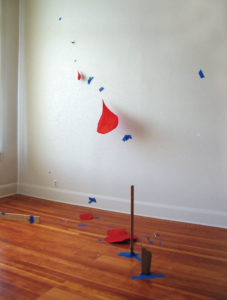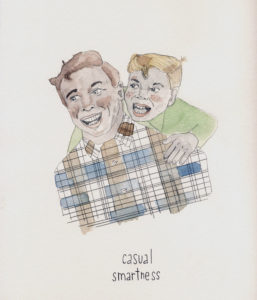Concrete Particularities presented works by Alice Cattaneo and Maria Forde that
explored life and culture in their precarious, laughable, and, at times, pathetic finitude.
Through quasi-scientific practices, each of these artists examines the limitations and desires that inform our human condition. They explore the banal materiality of objects and illusions, and dispel the over-inflated conventions of culture, in order to unearth possibilities of meaning in minutia.

Alice Cattaneo, Blood (detail), Felt, wood, tape, thread.
Alice Cattanneo employs primitive materials to construct objects and environments with the qualities of something “approximately there,” “a kind of thing,” “more or less this.” She reconstructs grandiose gestures and themes from Western culture, with cardboard, masking tape, bits of plastic or fabric, clay, and old fake flowers, focusing specifically—in the works in this show—on the conventions of opera: the ferocious princess, the naive lover, the beautiful astute courtesan, the secret letter. Alice distills these tropes to their most basic approximations, articulating only their essential points; in the process, she works to transmute their pompous over-inflation into something with a different impact and scale. The results often entail ironic reversals. The mechanics of artifice are self-consciously revealed, along with the inherent absurdity of the objects and the artist’s fascination with them. Alice’s distillations deflate, although not scornfully. The power of her work lies rather in her ability to explore the passions expressed in melodrama with humor and pathos. The objects and scenes she constructs are riddled with a fragile precariousness. She does not merely decry the exaggerations of high culture, but, in the eccentric particularity of her constructions, allows them to speak with a new honesty and humanity.

Maria Forde, Casual Smartness, Colored Pencil on paper
Maria Forde explores her attraction to particular people, objects and ideas through a rigorous practice of drawing and painting that simultaneously attends to the refinements of craft and the expressive singularities of textures and lines. Her work is rooted in an empirical study of experience that is informed by diverse aspects of life and culture, including music, movies, comics and books. She employs text to name objects and to animate characters and scenes. As studies, she often produces her drawings in series, which manifest the eccentric fascination that drives them as vividly as the details to which they attend: thirteen drawings on “things I like about basketball,” thirty-five sequential paintings on “how and why we listen to music.” Maria finds meaning in everyday objects: magnets, postcards, stuff in her dad’s garage. She discerns expression in the peculiarities of a distorted face, and relates to images in advertisements. Her work approaches the intersection between popular culture and personal life, high-art and kitsch. She explores avenues of meaning without imposing any self-important agenda, and shares her love of study, as a dedication to the eccentric exploration of concrete particularities, which is reflected in the precision with which she articulates her discoveries.